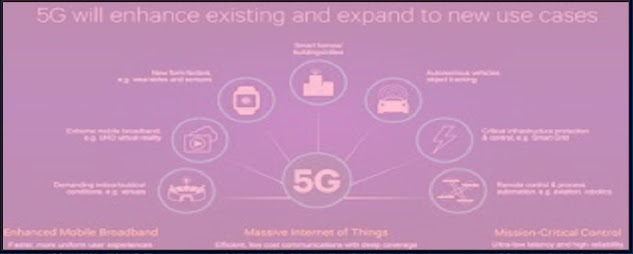The Rise of 5G Technology: What to Expect in the Next Generation of Connectivity. In our increasingly interconnected world, the
rapid evolution of technology continues to shape the way we live, work, and
communicate. One of the most significant technological advancements on the
horizon is the deployment of 5G technology, the fifth generation of wireless
communication. 5G promises to revolutionize our digital landscape, offering
faster speeds, lower latency, and a host of new possibilities.
In this article,
we will explore the rise of 5G technology, what it entails, and what we can
expect in the next generation of connectivity.
Understanding 5G Technology
To comprehend the potential impact of 5G, it’s
essential to grasp what sets it apart from its predecessors. 5G is not merely
an incremental improvement over 4G (LTE); it represents a fundamental shift in
wireless technology. Here are some key characteristics that define 5G:
1. Speed:
Perhaps the most touted feature of 5G is its blazing-fast speeds. While 4G
networks offer peak speeds of around 100 Mbps (megabits per second), 5G has the
potential to deliver speeds of up to 10 Gbps (gigabits per second). This means
that downloading large files, streaming high-definition content, and online
gaming will become virtually instantaneous.
2. Low
Latency: Latency refers to the delay between sending and receiving
data. 5G significantly reduces latency, with estimates ranging from 1 to 10
milliseconds. This near real-time responsiveness is crucial for applications
like remote surgery, autonomous vehicles, and augmented reality (AR).
3. Capacity:
5G networks can handle a much higher volume of connected devices
simultaneously. This scalability is essential as the Internet of Things (IoT)
continues to grow, with billions of devices expected to be connected to the
internet in the coming years.
4. Reliability:
5G networks are designed to be highly reliable, making them suitable for
critical applications such as emergency services and industrial automation.
5. Energy
Efficiency: 5G is more energy-efficient than previous generations,
which is a significant advantage as sustainability becomes a pressing concern.
Applications and Use Cases
The potential applications of 5G technology span
across various industries, unlocking new opportunities and capabilities:
1. Enhanced
Mobile Broadband (eMBB): 5G will provide mobile users with
unparalleled speeds for streaming, gaming, and downloading. High-definition
video conferencing and virtual reality experiences will become seamless.
2. IoT
and Smart Cities: With its ability to connect a massive number of
devices simultaneously, 5G will underpin the growth of smart cities.
Applications include smart traffic management, efficient energy use, and
improved public services.
3. Healthcare:
Telemedicine will see a significant boost with 5G, enabling remote
consultations, remote surgery with haptic feedback, and real-time monitoring of
patients’ vital signs.
4. Autonomous
Vehicles: The low latency and high reliability of 5G are critical for
self-driving cars. It allows for instant communication between vehicles and
infrastructure, enhancing safety and efficiency.
5. Manufacturing
and Industry 4.0: 5G facilitates the implementation of Industry 4.0,
where factories and machines communicate seamlessly, leading to greater
automation, efficiency, and reduced downtime.
6. Agriculture:
Precision agriculture will benefit from 5G’s ability to connect sensors and
devices in real-time, optimizing crop management and resource usage.
7. Education:
5G enables immersive and interactive learning experiences through AR and
virtual reality (VR), making education more engaging and accessible.
8. Gaming:
Cloud gaming platforms will thrive on 5G networks, as low latency and high
speeds allow gamers to stream games from the cloud without lag.
Challenges and Deployment
While 5G holds immense promise, its rollout is
not without challenges. One of the primary challenges is the need for a dense
network of small cells and infrastructure to deliver the promised speeds and
low latency. This requires significant investment and coordination between
telecommunication companies, governments, and local communities.
There are also concerns about the security of 5G
networks, as they will form the backbone of critical infrastructure and
services. Ensuring the integrity and privacy of data transmitted over 5G
networks will be paramount.
In terms of deployment, some regions and
countries have made significant progress in rolling out 5G networks, while
others are still in the early stages. Factors such as spectrum allocation,
regulatory frameworks, and technological readiness play a role in the pace of
deployment.
The Future of Connectivity
As 5G technology continues to mature and become
more widely available, it has the potential to reshape industries and improve
our daily lives in profound ways. From revolutionizing healthcare to powering
the cities of the future, the possibilities are virtually limitless.
However, it’s essential to recognize that the
full realization of 5G’s potential will take time. Over the next decade, we can
expect to see incremental advancements, expanding coverage, and the development
of new applications and use cases.
Conclusion
The rise of 5G technology represents a
transformative moment in the evolution of connectivity. With its unprecedented
speed, low latency, and capacity to connect billions of devices, 5G is poised
to revolutionize industries, enable new experiences, and drive innovation.
While challenges remain, the future of connectivity looks promising, ushering
in an era where technology seamlessly integrates with our lives in ways we canonly imagine today. As 5G networks continue to expand, we can anticipate a
world that is more connected, intelligent, and responsive than ever before.
SATNAM SHRI WAHEGURU SAHIB JI

